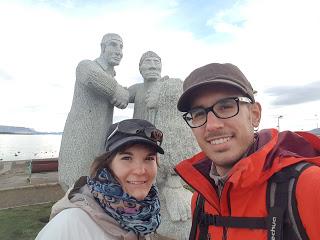
Después de reunirnos en Santiago de Chile volamos hacia Punta Arenas y desde ahí cogimos un autocar hacia Puerto Natales donde nos encontramos con Pavel, el gerente de AWASI Patagonia, que nos llevó hasta nuestra casa para los próximos meses.
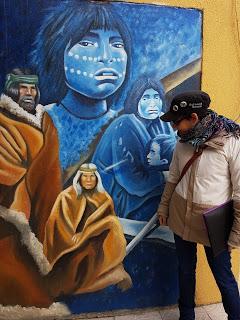
Vivir en La Patagonia representa un cambio bastante grande respecto a vivir en Lake Louise. Hemos pasado de vivir en un pueblecito en medio de las Montañas Rocosas a vivir en un campamento formado por contenedores de barco mercante “on site”, es decir, en los mismos terrenos que el lodge para el cual trabajamos: el Relais & Chateaux AWASI Patagonia. Concretamente estamos en la Estancia Tercera Barranca, justo en frente de las famosísimas Torres del Paine. Y lo más importante: estamos en primavera así que este año nos vamos a saltar el invierno.
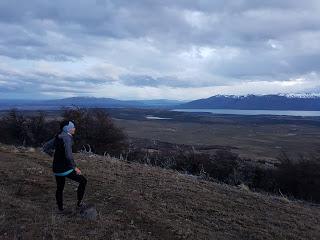
Para ir al pueblo más cercano, Puerto Natales donde no hay ni siquiera un pequeño cine, hay que conducir casi 200 km por carreteras de grava que serpentean por la pampa, la estepa, patagónica. En caso de querer ir por el camino rápido hay que cruzar el río Las Chinas, por el que no hay ningún puente construido. Una aventura en toda regla.
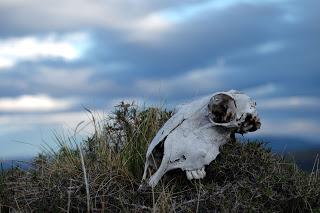
La Patagonia es salvaje. Esta es la primera impresión que tuvimos. La vegetación es dura, áspera, resistente… un poco como Clint Eastwood. Los arbustos y los árboles son achaparrados y macizos, encontrándose inclinados todos hacia la misma dirección, la del viento patagónico, que es fuerte, constante y muy frío. Las llanuras son inmensas, tanto que la vista no da más de sí y todavía se extienden más allá; hasta que llegan a la Cordillera de los Andes por el oeste (estamos en la única región de Chile que tiene los Andes al oeste), el Estrecho de Magallanes y la isla de Tierra del Fuego al sur y Argentina al este.
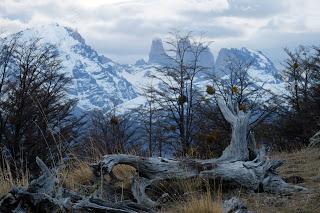
Los animales son también duros: está el cóndor, el ave de presa más grande del mundo, que entre otras cosas anida a 5000 metros de altura. Cuando nosotros estuvimos en Nepal caminando a 5000 metros de altitud no podíamos hablar y caminar a la vez debido a la falta de oxígeno en el aire. Está el guanaco, la versión pitbull de las yamas, el ñandú que es como un cruce entre un avestruz y un emú con cara de mucha mala uva, el armadillo, liebres grandes como perros labradores… y el más importante: el puma. Todos los animales locales son tanques de combate.
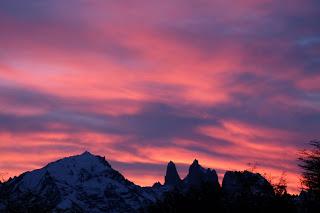
Hemos aprendido que La Patagonia no pertenece a ningún país, no hay Patagonia Chilena, Patagonia Argentina o Patagonia Brasileña… la patria de los patagones es simplemente La Patagonia y están muy orgullosos de ello. Y el emblema de La Patagonia son los gauchos, gentes como la vegetación: bajitos, duros, ásperos, de pocas palabras e incluso un poco inclinados por el viento.
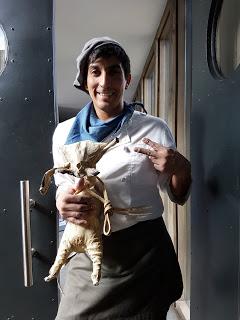
El primer gaucho al que conocimos fue Poroto, que ha vuelto a trabajar después de estar 10 meses de baja porque un caballo le aplastó la cadera, el fémur y la rodilla cuando estaba jineteando, que es como llaman aquí a los rodeos en los que montan a caballos salvajes, conocidos aquí como caballos baguales. Poroto tiene más metal en sus huesos que Lobezno y se pasa el día entero tomando mate. Se hizo su yerbero con la piel de un ternero no nato que una de sus vacas abortó. Yo creo que en realidad Poroto es de Bilbao.La Patagonia está al sur del sur. Todos los lugares a los que los chilenos se refieren como que están al sur, aquí tienen que cambiar y decir que, en realidad, están al norte. Somos como los Stark de Invernalia pero a la inversa, el Sur puro y duro, muy duro.
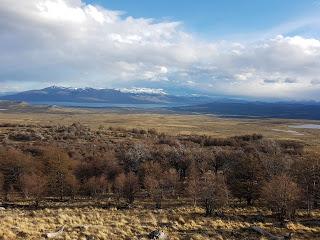
Y ya para acabar, la región en la que estamos se llama Última Esperanza por lo que aquí tenemos el “Hospital Última Esperanza”, los “Juzgados Última Esperanza” y, aunque aún no lo hemos visto seguro que está el “Tanatorio Última Esperanza” e incluso el “Burdel Última Esperanza”. Enrique & MarinaEnglish versionWE ARE IN PATAGONIA
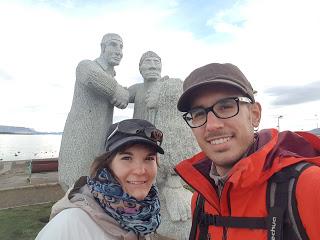
After my week in Atacama Enrique and I met again in Santiago de Chile to fly down to Punta Arenas together and then go to Puerto Natales by bus. From there, our new employer would take us to where it will be our home for the next months: Awasi Patagonia.
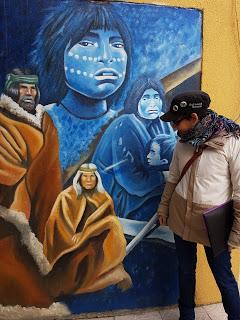
Our set up in Patagonia is going to be a pretty drastic change compared with Lake Louise. We’re going from living in an apartment in a tiny town in the middle of the Rockies to a room built in a shipping container on site. That means we will live and work in the same place. Therefore, we’ll live in a Relais and Chateaux property, beat that! Our address is Estancia Tercera Barranca, just in front of the famous Torres del Paine to be as precise as possible. And it’s spring down here, so guess who’s skipping winter this year.
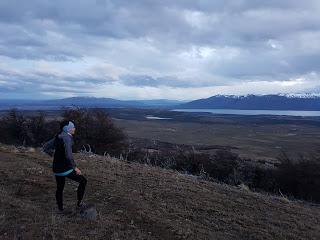
The closest town is Puerto Natales a place so small that there isn’t even a cinema. It’s 200 km away from us on a road that is mostly made of gravel and the rest is roughly tar sealed. There’s a shortcut between the hotel and Natales crossing Las Chinas river but there isn’t such thing as a bridge so taking it is completely weather dependant and a real adventure.
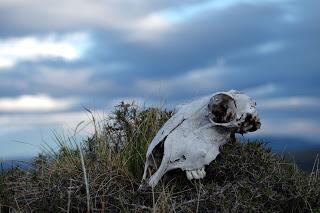
Patagonia is wild. That was our first impression. The native flora is rough, resilient, tough, like a Clint Eastwood made plant. Threes and bushes are solid and all hunched by the strong persistent cold Patagonic wind to the same side. The plains are vast, so extensive that your eyes can’t take so much land in just one glimpse. And still, in the middle of those plains the Andes Range spikes up towards the sky. Patagonia is the only region of Chile where the Andes stands on the West of the land, then there’s Tierra del Fuego on the South, Argentina on the East.
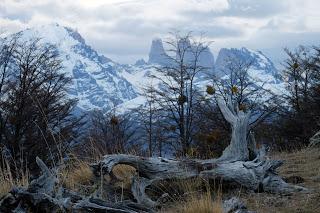
Fauna in the region is also tough. We have condors flying over our heads which are the biggest bird of prey on earth and they nest at up to 5.000 m high. Regular people has problems breathing at 5.000 m, and those birds decide to breed there. Unbelievable. We have guanacos which are the pit-bull version of a lama; nyandus, a mix between an ostrich and an emu but nastier than any of them; armadillos; hares as big as fully grown Labrador and of course pumas. No matter their size, all the local animals are war tanks.
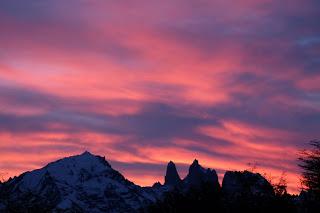
We’ve learnt that Patagonia doesn’t belong to any country. People from Patagonia isn’t from Chile, Argentina or Brazil, they belong to Patagonia and they’re so proud of it. The gauchos are the real locals here and likewise the vegetation they’re rough, dry, short, succinct and slightly bended with the wind.

The first gaucho we met was called Poroto. He was coming back to Awasi after 10 months on medical leave. A horse broke his hips, femur and knee when Poroto was jineteando which is the Chilean way to call a rodeo. He was riding a wild horse, called caballo bagual here in Chile, to tame it but it didn’t work as expected. At the end, Poroto ended up with more metal in his skeleton than Wolverine and now spends most of his days drinking mate out of a yerbero that he made out of the skin of unborn cow fetus.Patagonia is South of South. All the places that Chileans describe as South are North from here. We’re the equivalent South to the Starks of Winterfell, we’re in the real South of the South.
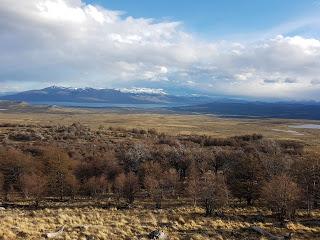
And to top it up, the name of the region Última Esperanza translates literally as Last Hope. Then we have the Last Hope court house, the Last Hope brewery and we’re sure there’s a Last Hope morge and a Last Hope brothel somewhere. Enrique & Marina
